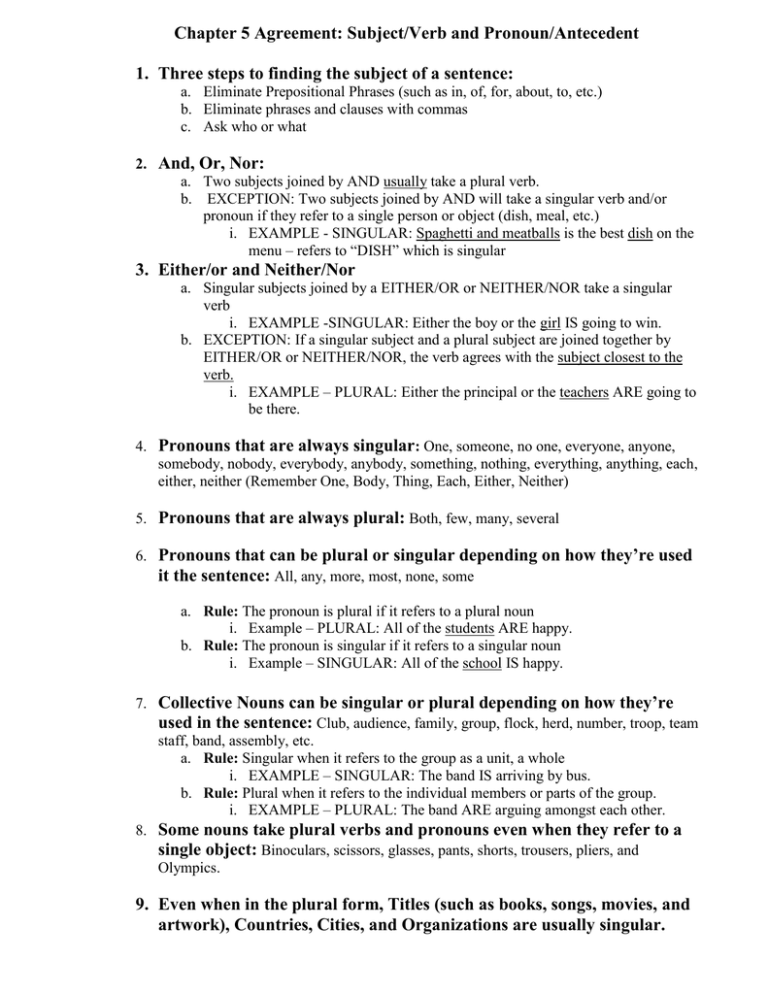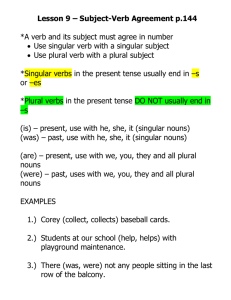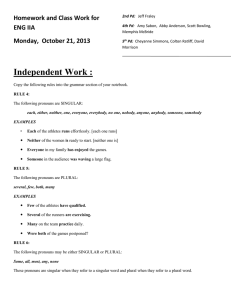Chapter 5 Agreement: Subject/Verb and Pronoun/Antecedent
advertisement

Chapter 5 Agreement: Subject/Verb and Pronoun/Antecedent 1. Three steps to finding the subject of a sentence: a. Eliminate Prepositional Phrases (such as in, of, for, about, to, etc.) b. Eliminate phrases and clauses with commas c. Ask who or what 2. And, Or, Nor: a. Two subjects joined by AND usually take a plural verb. b. EXCEPTION: Two subjects joined by AND will take a singular verb and/or pronoun if they refer to a single person or object (dish, meal, etc.) i. EXAMPLE - SINGULAR: Spaghetti and meatballs is the best dish on the menu – refers to “DISH” which is singular 3. Either/or and Neither/Nor a. Singular subjects joined by a EITHER/OR or NEITHER/NOR take a singular verb i. EXAMPLE -SINGULAR: Either the boy or the girl IS going to win. b. EXCEPTION: If a singular subject and a plural subject are joined together by EITHER/OR or NEITHER/NOR, the verb agrees with the subject closest to the verb. i. EXAMPLE – PLURAL: Either the principal or the teachers ARE going to be there. 4. Pronouns that are always singular: One, someone, no one, everyone, anyone, somebody, nobody, everybody, anybody, something, nothing, everything, anything, each, either, neither (Remember One, Body, Thing, Each, Either, Neither) 5. Pronouns that are always plural: Both, few, many, several 6. Pronouns that can be plural or singular depending on how they’re used it the sentence: All, any, more, most, none, some a. Rule: The pronoun is plural if it refers to a plural noun i. Example – PLURAL: All of the students ARE happy. b. Rule: The pronoun is singular if it refers to a singular noun i. Example – SINGULAR: All of the school IS happy. 7. Collective Nouns can be singular or plural depending on how they’re used in the sentence: Club, audience, family, group, flock, herd, number, troop, team staff, band, assembly, etc. a. Rule: Singular when it refers to the group as a unit, a whole i. EXAMPLE – SINGULAR: The band IS arriving by bus. b. Rule: Plural when it refers to the individual members or parts of the group. i. EXAMPLE – PLURAL: The band ARE arguing amongst each other. 8. Some nouns take plural verbs and pronouns even when they refer to a single object: Binoculars, scissors, glasses, pants, shorts, trousers, pliers, and Olympics. 9. Even when in the plural form, Titles (such as books, songs, movies, and artwork), Countries, Cities, and Organizations are usually singular. 10. An amount, such as a measurement, a fraction, a percentage may be singular or plural depending on how it is used a. Rule: An amount is singular when it is thought of as a unit. i. EXAMPLE – SINGULAR: Two hundred dollars IS a large sum of money. b. Rule: An amount is plural when it is thought of as separate parts i. EXAMPLE – PLURAL: Three hundred dollars ARE scattered all over the street like rain. c. Rule: A fraction or percentage is singular when it refers to a singular word i. EXAMPLE – SINGULAR: One fourth of the student body IS unemployed. d. Rule: A fraction or percentage is plural when it refers to a plural word. i. EXAMPLE - PLURAL: One fourth of the students ARE ditching. e. Rule: A measurement (length, height, weight, capacity, area, etc.) is usually singular. i. EXAMPLE – SINGULAR: Fifty-five miles IS a long way to go. 11.Subjects preceded by every or many a take a singular verb and pronoun. a. EXAMPLE: Every student is here with his or her parents. b. EXAMPLE: Many a student has graduated from La Quinta. SUMMARY CHART Always Plural Many Some Few Most Several Binoculars, scissors, glasses, pants, shorts, trousers, pliers, and Olympics. . Always Singular One Anybody Everyone Everything No One Something Someone Nothing Anyone Anything Everybody Each Nobody Either Somebody Neither Titles (such as books, songs, movies, and artwork), Countries, Cities, and Organizations A Measurement (length, height, weight, capacity, area, etc.) is usually singular Plural or Singular All Any More Most None Some Neither/Nor Either/Or Groups: club, audience, family, group, flock, herd, number, troop, team staff, band, assembly, etc. Amounts: Money, a Fraction, a Percentage, etc. Singular or Plural? Rule One: If it refers to a plural noun, it is plural. If it refers to a singular noun, it is singular. Singular or Plural? Rule One: If it refers to the group as a unit, it is singular. If it refers to the parts or individuals of the group, it is plural. A Great Clue for You: Subject /Verb agreement and Pronoun/Antecedent agreement go hand in hand. The same rules apply to each, and they predict each other. Check it out: If the subject takes a singular verb, it will also take a singular pronoun, and vice versa. If the subject takes a plural verb, it will also take a plural pronoun, and vice versa.








